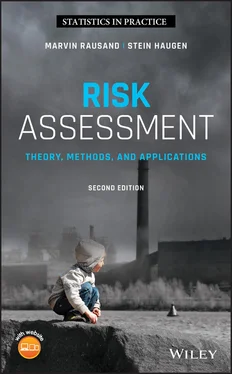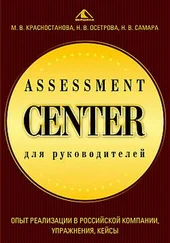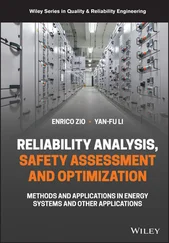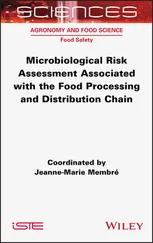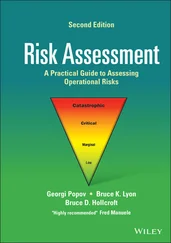There has been considerable research into the VSL, and different VSL values have been used in specific studies. The VSL values typically range from 1 to 15 million USD in different countries and different industries.
Observe that the VSL is not a “value (or price) of life” in the sense of a sum that any given individual would accept in compensation for the certainty of his or her own death. Rather, it is derived from studies of what a company or the public would be willing to pay for a reduction in already low levels of residual risk. VSL is hence a measure of a company's or society's values.
Several similar concepts are sometimes used. Among these are the following:
1 Societal willingness to pay. The principle is described in more detail by Pandey and Nathwani (2004), who propose to include a life quality index in the assessment of our willingness to pay.
2 Value of averting (or preventing) a fatality (VAF). This is an aggregate willingness to pay for typically very small reductions in the individual probability of death.
3 Implied cost of averting a fatality (ICAF). The International Maritime Organization (IMO) uses the ICAF as part of its decision rules:(5.1)
4 Net cost of averting a fatality (NCAF). This measure accounts for the economic benefits of risk reduction measures. Economic benefits (or risk reduction) may include the economic value of reduced pollution.
5.2.3 Equity, Utility, and Technology
HSE (2001) describes three “pure” principles that can be applied when establishing RAC for personnel. The three principles are called the equity, utility , and technology principles and can briefly be described as follows.
The equity principle is based on the underlying assumption that all individuals should have a minimum protection against injury and fatality. This does not necessarily mean that everyone are treated “equally,” but in practice, it means that no one should be exposed to risk above a certain level. If the equity principle is applied, a maximum risk level for individuals is thus established, and this acts as our acceptance criterion. This implies that if the risk is above this maximum level, measures to reduce risk should be implemented to reach at least the maximum acceptable level, regardless of the cost of reducing risk. The equity principle can be regarded as a principle that focuses on the individual.
5.2.3.2 Utility Principle
The utility principle takes a different view on acceptable risk. The underlying assumption here is that society has limited resources that can be applied to reduce risk, although the extent of these resources depends on the benefit from taking the risk. Because we have limited resources, the utility principle implies that we should use these resources to get the maximum benefit, that is, the greatest possible risk reduction with the resources we have. The effect of this approach may be that even if some individuals or groups are exposed to very high risk, the utility principle may still dictate that priority should be given to people with lower risk because it is cheaper to reduce risk for these. The utility principle is focused on maximum utilization of available resources.
5.2.3.3 Technology Principle
The two above principles explicitly address risk in different ways, whereas the technology principle only indirectly addresses risk. The underlying assumption of this principle is that we are surrounded by technology that society has accepted that we use. Implicitly, the risk associated with this technology has been accepted without being based on risk assessment. The principle states that as long as we use “state‐of‐the‐art” technology, the risk level should be acceptable. In many respects, managing risk through standards and guidelines is an implicit application of the technology principle. Sometimes, the expression best available technology (BAT) is used. Once more, we see that the practical implications of this principle are different from the other two. The technology principle does not guarantee that all individuals are exposed to a risk below a certain maximum because there may be large variations in how safe different technologies are. Neither will it guarantee that we get maximum utility for the resources we put in, as the technological development and costs associated with the technology may vary significantly between sectors.
5.3 Approaches to Establishing Risk Acceptance Criteria
A number of different approaches have been developed for establishing RAC. Some of the most commonly used approaches are described briefly below.
5.3.1 The ALARP Principle
The origin of the ALARP principle can be found in a court case from the UK (Court of Appeal 1949). There had been a fatal accident in a coal mine due to collapse of the roof of one of the tunnels, and the bereaved sued the National Coal Board for compensation. One of the judges in the Court of Appeal stated:
“Reasonably practicable” is a narrower term than “physically possible” and seems to me to imply that a computation must be made by the owner, in which the quantum of risk is placed on one scale and the sacrifice involved in the measures necessary for averting the risk (whether in money, time or trouble) is placed in the other; and that if it be shown that there is a gross disproportion between them – the risk being insignificant in relation to the sacrifice – the defendants discharge the onus on them.
If we interpret this, it essentially says that we need to compare the risk with the cost of reducing risk. If the cost is too high compared to the benefit we achieve, it is not required to reduce risk. This is at the very core of the ALARP principle.
ALARP
1 It provides a framework for evaluating risk (i.e. deciding on need for reducing risk). This requires explicit description and analysis of risk tolerability.
2 It involves a method of determining if the cost of a risk reduction measure is disproportionate to the benefits it will provide, and hence if the measure should be implemented.
When using the ALARP principle, the risk is divided into three levels, as shown in Figure 5.1(HSE 2001):
1 An unacceptable region, where the risk is intolerable except in extraordinary circumstances, and risk reduction measures are mandatory.
2 A middle band, or ALARP region, where risk reduction measures are desirable but may not be implemented if their cost is grossly disproportionate to the benefit gained.
3 A broadly acceptable region, where no further risk reduction measures are needed. In this region, further risk reduction is uneconomical and resources could be spent better elsewhere to reduce the total risk.
We thus have to state two risk limits: an upper limit (i.e. between the unacceptable region and the ALARP region) over which the risk cannot be justified on any grounds, and a lower limit (i.e. between the ALARP region and the broadly acceptable region) under which the risk is considered generally acceptable.
If we look back at the three “pure” principles of risk acceptance, ALARP incorporates all three of these:
The equity principle is incorporated through the upper limit above which risk is unacceptable.
The utility principle is incorporated in the ALARP region, where risk is accepted if the cost of reducing risk is too high.
The technology principle is in practical use incorporated in the ALARP region because there is an expectation that “good practice” is followed when decisions are made regarding what measures to implement and not.
The ALARP principle was introduced in the framework on tolerability of risk (TOR) from UK nuclear stations (HSE 1992), and has subsequently been adapted for general applications in HSE (2001).
Читать дальше
